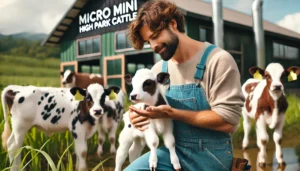Micro Mini High Park Cattle—a small, hardy, and environmentally friendly breed that is changing how farmers and homesteaders think about cattle. Below, we dive into the unique attributes, environmental benefits, and practical applications of these cattle, showcasing their role in revolutionizing sustainable agriculture.
Introduction to Micro Mini High Park Cattle
What Are Micro Mini High Park Cattle?
Micro Mini High Park Cattle are a distinctive breed developed from the larger High Park cattle breed. Known for their compact size and unique appearance, these cattle possess genetic traits suited for small-scale and sustainable farming.
Origins and Breeding History
The breed emerged as a specialized adaptation of the larger High Park cattle, drawing genetic lines from both Highland and other small-bodied cattle to achieve a hardy, miniature size without sacrificing productivity or resilience.
Key Characteristics and Appearance
Micro Mini High Park Cattle are recognized for their small stature, typically reaching 36-42 inches at the shoulder, making them ideal for farms with limited space. Their thick, shaggy coats—often in shades of black, white, or dun—help them withstand diverse climates while maintaining excellent health.
The Importance of Sustainable Farming
Sustainable farming aims to meet current food demands while preserving resources for future generations. Livestock plays a critical role in this balance, as animal agriculture is often resource-intensive. Choosing breeds like Micro Mini High Park Cattle that require fewer resources and emit less methane aligns with sustainable goals, reducing environmental strain while supporting food security.
Unique Features of Micro Mini High Park Cattle
Size and Weight Advantages
With an average weight between 300-500 pounds, these cattle are easier to handle and require less feed compared to larger breeds. Their small size also limits the wear on land, minimizing soil compaction and erosion—crucial for maintaining soil health.
Adaptability to Varied Climates
Thanks to their dense coat, Micro Mini High Park Cattle are well-suited to cold climates, though they adapt comfortably to warmer environments as well, making them versatile across different regions.
Low Maintenance and Feed Requirements
Their smaller stature and slow metabolism mean they consume far less than traditional cattle. They can thrive on natural forage and moderate supplemental feed, making them a cost-effective choice for farmers.
Benefits of Micro Mini High Park Cattle for Sustainable Farming
Reduced Carbon Footprint
Their efficient grazing habits and low feed requirements help lower the farm’s carbon footprint. In contrast to larger cattle breeds, they produce fewer methane emissions, which is essential in tackling greenhouse gases.
Land and Resource Efficiency
Micro Mini High Park Cattle require less grazing land, water, and feed than traditional cattle, making them suitable for small farms or even urban farms. This efficiency allows farmers to maximize productivity on minimal land.
Ideal for Small-Scale and Urban Farms
With their compact size, these cattle can comfortably fit into smaller spaces, making them ideal for small-scale farms, urban agriculture projects, and backyard homesteads looking to engage in livestock rearing without extensive land.
Feeding and Nutrition Requirements
Diet Requirements Compared to Traditional Cattle
Micro Mini High Park Cattle need less feed due to their smaller size. They can easily subsist on grass, hay, and foraged plants, making them a natural fit for farms practicing rotational grazing.
Pasture and Forage Utilization
Since they consume smaller amounts, they can graze on modest pasture areas, allowing pastures time to regenerate. Their light grazing habits support plant growth and reduce the need for soil interventions.
Impact on Land Fertility and Soil Health
The cattle’s natural grazing and moderate manure production contribute positively to soil health, providing essential nutrients and organic matter without overwhelming the land.
Health and Immunity Traits
Micro Mini High Park Cattle are robust and generally require minimal veterinary intervention. This breed's selective breeding has enhanced their natural resistance to many common cattle ailments, promoting animal health and reducing the need for antibiotics.
Grazing and Land Management
Micro Mini High Park Cattle’s grazing habits support natural grassland regeneration, preventing overgrazing and aiding in soil conservation. They align well with regenerative farming techniques, enhancing biodiversity and soil health.
Micro Mini High Park Cattle and Carbon Sequestration
Grazing Techniques That Support Carbon Capture
Their grazing patterns allow grasses to capture and store carbon in the soil more effectively. Combined with lower methane output, they contribute to a more carbon-neutral livestock system.
Economic Benefits for Small Farmers
Micro Mini High Park Cattle offer an accessible entry point for new or small-scale farmers. Their low upkeep costs, minimal feed needs, and niche market value make them a high-return investment for sustainable farming.
Breeding and Reproduction
High fertility rates and the ability to reproduce with other small cattle breeds make Micro Mini High Park Cattle a viable option for farmers looking to expand their herds sustainably.
Frequently Asked Questions (FAQs)
What is the average size and weight of Micro Mini High Park Cattle?
- Typically, they stand around 36-42 inches at the shoulder and weigh between 300-500 pounds.
Are they suitable for beginner farmers?
- Yes, their low maintenance and calm temperament make them ideal for novice livestock farmers.
How do they compare to other small cattle breeds like Dexter or Jersey?
- Micro Mini High Park Cattle require less space and feed, making them especially suitable for compact farms.
Do they require special care?
- No, they are hardy and need only basic livestock care, although regular veterinary check-ups are recommended.
What is their typical lifespan?
- They can live up to 15-20 years with proper care.
Can they be raised on a small homestead or backyard farm?
- Yes, their small size and minimal resource needs make them a great fit for small farms or homesteads.













